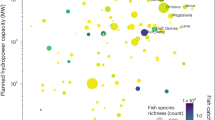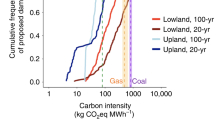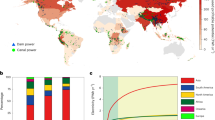Abstract
The Amazon Basin is Brazil’s next frontier for hydropower, but alterations to the water cycle from climate change and deforestation could affect river flows fuelling electricity generation. This research investigated the effects of global and regional changes to the largest network of planned and existing dams within a single basin in the Amazon (the Tapajόs River), which altogether accounts for nearly 50% of the inventoried potential expansion in Brazil. Future hydrological conditions could delay the period of maximum daily generation by 22–29 d, worsening the mismatch between seasonal electricity supply and peak demand. Overall, climate change could decrease dry season hydropower potential by 430–312 GWh per month (−7.4 to −5.4%), while combined effects of deforestation could increase interannual variability from 548 to 713–926 GWh per month (+50% to +69%). Incorporating future change and coordinating dam operations should be a premise in energy planning that could help develop more resilient energy portfolios.
This is a preview of subscription content, access via your institution
Access options
Access Nature and 54 other Nature Portfolio journals
Get Nature+, our best-value online-access subscription
$29.99 / 30 days
cancel any time
Subscribe to this journal
Receive 12 digital issues and online access to articles
$119.00 per year
only $9.92 per issue
Buy this article
- Purchase on Springer Link
- Instant access to full article PDF
Prices may be subject to local taxes which are calculated during checkout




Similar content being viewed by others
Data availability
The data that support the findings of this study are available from the corresponding author upon reasonable request.
References
International Energy Outlook 2016 (US Energy Information Administration, 2016).
Hydropower Status Report 41 (IHA, 2016); http://www.hydropower.org/
Grill, G. et al. Mapping the world’s free-flowing rivers. Nature 569, 215–221 (2019).
Poff, N. L., Olden, J. D., Merritt, D. M. & Pepin, D. M. Homogenization of regional river dynamics by dams and global biodiversity implications. Proc. Natl Acad. Sci. USA 104, 5732–5737 (2007).
Anderson, E. P. et al. Understanding rivers and their social relations: a critical step to advance environmental water management. WIREs Water 6, e1381 (2019).
Moran, E. F., Lopez, M. C., Moore, N., Müller, N. & Hyndman, D. W. Sustainable hydropower in the 21st century. Proc. Natl Acad. Sci. USA 115, 11891–11898 (2018).
Winemiller, K. O. et al. Balancing hydropower and biodiversity in the Amazon, Congo, and Mekong. Science 351, 128–129 (2016).
Anderson, E. P. et al. Fragmentation of Andes-to-Amazon connectivity by hydropower dams. Sci. Adv. 4, eaao1642 (2018).
Arias, M. E. et al. Impacts of hydropower and climate change on drivers of ecological productivity of Southeast Asia’s most important wetland. Ecol. Modell. 272, 252–263 (2014).
Finer, M. & Jenkins, C. N. Proliferation of hydroelectric dams in the Andean Amazon and implications for Andes–Amazon connectivity. PLoS ONE 7, e35126 (2012).
Piman, T., Cochrane, T. A. & Arias, M. E. Effect of proposed large dams on water flows and hydropower production in the Sekong, Sesan and Srepok Rivers of the Mekong Basin. River Res. Appl. 32, 2095–2108 (2016).
Schmitt, R. J. P., Bizzi, S., Castelletti, A. & Kondolf, G. M. Improved trade-offs of hydropower and sand connectivity by strategic dam planning in the Mekong. Nat. Sustain. 1, 96–104 (2018).
Ziv, G., Baran, E., Nam, S., Rodriguez-Iturbe, I. & Levin, S. A. Trading-off fish biodiversity, food security, and hydropower in the Mekong river basin. Proc. Natl Acad. Sci. USA 109, 5609–5614 (2012).
Strand, J. et al. Spatially explicit valuation of the Brazilian Amazon forest’s ecosystem services. Nat. Sustain. 1, 657–664 (2018).
Coe, M. T. et al. Deforestation and climate feedbacks threaten the ecological integrity of south–southeastern Amazonia. Philos. Trans. R. Soc. B 368, 20120155 (2013).
Davidson, E. A. et al. The Amazon basin in transition. Nature 481, 321–328 (2012).
Duffy, P. B., Brando, P., Asner, G. P. & Field, C. B. Projections of future meteorological drought and wet periods in the Amazon. Proc. Natl Acad. Sci. USA 112, 13172–13177 (2015).
Farinosi, F. et al. Future climate and land use change impacts on river flows in the Tapajós basin in the Brazilian Amazon. Earth’s Future 7, 993–1017 (2019).
Sorribas, M. V. et al. Projections of climate change effects on discharge and inundation in the Amazon basin. Clim. Change 136, 555–570 (2016).
Zhang, K. et al. The fate of Amazonian ecosystems over the coming century arising from changes in climate, atmospheric CO2 and land-use. Glob. Change Biol. 21, 2569–2587 (2015).
Nobre, C. A. et al. Land-use and climate change risks in the Amazon and the need of a novel sustainable development paradigm. Proc. Natl Acad. Sci. USA 113, 10759–10768 (2016).
Stickler, C. M. et al. Dependence of hydropower energy generation on forests in the Amazon basin at local and regional scales. Proc. Natl Acad. Sci. USA 110, 9601–9606 (2013).
Energy Resources Potential in the 2050 Horizon (EPE, 2018); https://go.nature.com/2TiiSvS
Operational Capacity Factor (Itaipu Bionacional, 2019); https://go.nature.com/2T6VhiV
Marengo, J. A. et al. Changes in climate and land use over the Amazon Region: current and future variability and trends. Frontiers in Earth Science 6, 228 (2018).
Outlook and Perspective on Regional Energy Integration (EPE, 2018); https://go.nature.com/2vomX9U
Escobar, H. Drought triggers alarms in Brazil’s biggest metropolis. Science 347, 812–812 (2015).
Fu, R. et al. Increased dry-season length over southern Amazonia in recent decades and its implication for future climate projection. Proc. Natl Acad. Sci. USA 110, 18110–18115 (2013).
Guimberteau, M. et al. Impacts of future deforestation and climate change on the hydrology of the Amazon basin: a multi-model analysis with a new set of land-cover change scenarios. Hydrol. Earth Syst. Sci. 21, 1455–1475 (2017).
Arias, M. E., Lee, E., Farinosi, F., Pereira, F. F. & Moorcroft, P. R. Decoupling the effects of deforestation and climate variability in the Tapajós river basin in the Brazilian Amazon. Hydrol. Process. 32, 1648–1663 (2018).
World Commission on Dams Dams and Development. A New Framework for Decision-Making (Earthscan Publications, 2000).
Kareiva, P. M. Dam choices: analyses for multiple needs. Proc. Natl Acad. Sci. USA 109, 5553–5554 (2012).
Ray, P. A. & Brown, C. M. Confronting Climate Uncertainty in Water Resources Planning and Project Design: The Decision Tree Framework (World Bank, 2015).
Hydropower Climate Resilience Guide (IHA, 2019); http://www.hydropower.org/
Poff, N. L. & Olden, J. D. Can dams be designed for sustainability? Science 358, 1252–1253 (2017).
Sabo, J. L. et al. Designing river flows to improve food security futures in the Lower Mekong Basin. Science 358, eaao1053 (2017).
Jager, H. I. & Smith, B. T. Sustainable reservoir operation: can we generate hydropower and preserve ecosystem values? River Res. Appl. 24, 340–352 (2008).
Water Resources Strategic Plan of the Right Margin of the Amazon River (ANA, 2011).
Freshwater Ecoregions Of the World: Tapajos–Juruena (WWF/TNC, 2013); http://www.feow.org/ecoregions/details/320
Moorcroft, P. R., Hurtt, G. C. & Pacala, S. W. A method for scaling vegetation dynamics: the ecosystem demography model (ED). Ecol. Monogr. 71, 557–586 (2001).
Medvigy, D., Wofsy, S. C., Munger, J. W., Hollinger, D. Y. & Moorcroft, P. R. Mechanistic scaling of ecosystem function and dynamics in space and time: Ecosystem Demography model version 2. J. Geophys. Res. 114, G01002 (2009).
Levine, N. M. et al. Ecosystem heterogeneity determines the ecological resilience of the Amazon to climate change. Proc. Natl Acad. Sci. USA 113, 793–797 (2016).
Pereira, F. F. et al. Technical note: a hydrological routing scheme for the ecosystem demography model (ED2+R) tested in the Tapajós river basin in the Brazilian Amazon. Hydrol. Earth Syst. Sci. 21, 4629 (2017).
Piman, T., Cochrane, T. A., Arias, M. E., Green, A. & Dat, N. D. Assessment of flow changes from hydropower development and operations in Sekong, Sesan, and Srepok Rivers of the Mekong Basin. J. Water Resour. Plann. Manag. 139, 723–732 (2012).
Good, P., Jones, C., Lowe, J., Betts, R. & Gedney, N. Comparing tropical forest projections from two generations of Hadley Centre Earth System models, HadGEM2-ES and HadCM3LC. J. Clim. 26, 495–511 (2013).
Sillmann, J., Kharin, V. V., Zhang, X., Zwiers, F. W. & Bronaugh, D. Climate extremes indices in the CMIP5 multimodel ensemble: Part 1. Model evaluation in the present climate. J. Geophys. Res. 118, 1716–1733 (2013).
Hurtt, G. C. et al. The underpinnings of land-use history: three centuries of global gridded land-use transitions, wood-harvest activity, and resulting secondary lands. Glob. Change Biol. 12, 1208–1229 (2006).
Soares-Filho, B. S. et al. Modelling conservation in the Amazon basin. Nature 440, 520–523 (2006).
Swann, A. L. S., Longo, M., Knox, R. G., Lee, E. & Moorcroft, P. R. Future deforestation in the Amazon and consequences for South American climate. Agric. Meteorol. 214–215, 12–24 (2015).
Longo, M. et al. The biophysics, ecology, and biogeochemistry of functionally diverse, vertically and horizontally heterogeneous ecosystems: the Ecosystem Demography model, version 2.2 – Part 2: Model evaluation for tropical South America. Geosci. Model Dev. 12, 4347–4374 (2019).
Carl, B. HEC-PRM Prescriptive Reservoir Model User’s Manual (US Army Corp of Engineers, 2003); https://www.hec.usace.army.mil/software/hec-resprm/
DiMiceli, C. M. et al. Annual Global Automated MODIS Vegetation Continuous Fields (MOD44B) at 250 m Spatial Resolution for Data Years Beginning Day 65, 2000–2010 Collection 5: Percent Tree Cover (Univ. Maryland, 2011).
Lehner, B. & Grill, G. Global river hydrography and network routing: baseline data and new approaches to study the world’s large river systems. Hydrol. Process. 27, 2171–2186 (2013).
Lehner, B., Verdin, K. & Jarvis, A. New global hydrography derived from spaceborne elevation data. Eos 89, 93–94 (2008).
Acknowledgements
This work was initiated while M.E.A., E.L., F.F. and A.L. were Giorgio Ruffolo Fellows in the Sustainability Science Program at Harvard University. Support from Italy’s Ministry for Environment, Land and Sea is gratefully acknowledged. F.F. was also funded through a doctoral scholarship by the Ca’ Foscari University of Venice. The authors dedicate this study to the late Professor John Briscoe (1948–2014), who envisioned and co-led the Amazon Initiative of Harvard’s Sustainability Science Program.
Author information
Authors and Affiliations
Contributions
M.E.A., F.F., P.R.M. and J.B. designed the study. M.E.A. and F.F. collected and compiled the data. F.F., E.L. and M.E.A. designed the experiments and ran computer simulations. M.E.A. and F.F. carried out the data analysis. M.E.A. prepared all figures. M.E.A., F.F., E.L., A.L. and P.R.M. wrote the paper.
Corresponding author
Ethics declarations
Competing interests
The authors declare no competing interests.
Additional information
Publisher’s note Springer Nature remains neutral with regard to jurisdictional claims in published maps and institutional affiliations.
Supplementary information
Supplementary Information
Supplementary Figs. 1–3, Tables 1–3 and references.
Rights and permissions
About this article
Cite this article
Arias, M.E., Farinosi, F., Lee, E. et al. Impacts of climate change and deforestation on hydropower planning in the Brazilian Amazon. Nat Sustain 3, 430–436 (2020). https://doi.org/10.1038/s41893-020-0492-y
Received:
Accepted:
Published:
Issue Date:
DOI: https://doi.org/10.1038/s41893-020-0492-y
This article is cited by
-
Bias Correction in CMIP6 Models Simulations and Projections for Brazil’s Climate Assessment
Earth Systems and Environment (2024)
-
Changes in rainfall seasonality in Serbia from 1961 to 2020
Theoretical and Applied Climatology (2024)
-
Climate classification by Thornthwaite (1948) humidity index in future scenarios for Maranhão State, Brazil
Environment, Development and Sustainability (2023)
-
Geophysical Constraints on Decarbonized Systems—Building Spatio-Temporal Uncertainties into Future Electricity Grid Planning
Current Sustainable/Renewable Energy Reports (2023)
-
Deforestation impacts on dengue incidence in the Brazilian Amazon
Environmental Monitoring and Assessment (2023)



